Interview with Meghan Shimek: Fiber Artist, Tarot Reader, & Single Mom
Every teacher I have had has been a woman. I have a great belief that the more people know about a craft or skill the more they and others will respect it. I also believe there is enough room for all.
This interview was originally published in 2016 by Fempotential. It has not been updated before re-publication and we should not presume that the artist feels the exact same way about everything today. Humans change and grow. Regardless, the words and work are powerful.
Meghan Bogden Shimek is a fiber artist and weaver based in Oakland, California who uses textiles to explore themes of loss, discomfort and healing. She is trained in traditional tapestry and Navajo weaving techniques and combines those skills with organic movement inspiration to create artistic wall hangings that are rich in texture and reminiscent of landscapes. In this interview she gives us insight into her artwork and shares what it’s like to be a professional artist and the single mom of a young child, including how helpful it is to rely on a community of women for support.
Kathryn: Many people find it difficult to pursue art as a profession. What has your journey with this been like?
Meghan: I think I have had a pretty unique experience. My background is in history and nutrition; I didn’t go to art school. When my son was born I had been working for a nonprofit and decided to stay home with him as my salary wouldn’t cover the cost of childcare in the Bay Area. I began weaving and would often stay up nights and wake up early to learn and pursue my craft.
I was fortunate that at the time I didn’t have to work outside the home and when I started to have opportunities to teach, it was at the same time that I was interested in going back to work. My husband and I split up in January 2015 and I had to make the decision to jump into weaving full-time or go back to a more traditional job in my field.
I decided to give myself one year to see how things would go; could I make art full-time and have it be sustainable? It has now been well over a year and so far I am making it work. I try to diversify so that I am not reliant on one avenue of income; I teach classes, I sell looms, I make wall art for homes and I try very hard to spend some time every week working on art that is just for me.
Kathryn: What are the challenges and blessings of being a working artist as well as a mother? Do the responsibilities of each conflict with each other at all?
Meghan: Oh yes! I am a single mother, so when I have my son I have my son! I find it very difficult to work while he is around. It is hard to concentrate and really be able to dive into my work, so I try to work while he is at school or at his fathers’ house.
Being a mother to Grey has been incredible. It has made me slow down to look at every rock, to get outdoors more, to go swimming whenever we can. I absolutely would not have started weaving if it weren’t for him!
It is extremely challenging too, though. I don’t think I am particularly “maternal”. Many of my friends seem to be so able, and I find many days that it is a struggle to be a mom. Sometimes I will feel inspired and stay up all night working and then have to get up at 6 or 7 with Grey. I have been trying to find more of a work/life balance and not feel guilty to take more time for myself, both when I have him and on the weekends when I don’t have him.
Kathryn: It sounds like you have a strong community of women around you, right? Who are some of your role models?
Meghan: I definitely feel like I am a part of a community of women and many of them are role models to me. My mother, of course, is number one. She is so strong and brave and she is so giving. She will do anything for my brother and I. She has always been there for me and supports me through everything, even when she doesn’t agree with my choices.
Erin Conger, who is an incredible photographer, is definitely an inspiration. She and I have been on a very similar journey over the last couple years and we have an understanding between us without really even needing to speak. Alise Anderson is another of the most creative women I know. Her mind never stops and I am so impressed with all that she creates. She has been killing it this year and I wish I had an eighth of the energy she has! There are probably 50 more women I could list, but these were the first that popped into my mind.
Here in the Bay Area there is such a rich sense of community and collaboration. I feel completely supported. I think everyone truly tries to help one another out. I have also found an amazing community through the Internet, especially Instagram. I have reconnected with people and been able to stay at people’s homes when I travel. I try to open my house to visitors whenever I can; meeting people from around the world is so beautiful and enriching.
Kathryn: And you have learned your weaving techniques from other women, correct? And now you pass on those skills to others through your own workshop. What can you tell us about the transmission of craft from one individual to the next?
Meghan: Every teacher I have had has been a woman. I have a great belief that the more people know about a craft or skill the more they and others will respect it. I also believe there is enough room for all of us to find our thing and be successful at it. Weaving, especially, can be a very solitary art form; you can spend hours and days alone in front of a loom. This suits my personality, as I am often overwhelmed when I am around people too often.
However, there is something so special about sharing your knowledge. I learn more from my students than they learn from me. I find them to be constant sources of inspiration and I have formed close friendships with many of them. It helps to build community. I personally learn from doing something; watching videos online can be helpful for one aspect, but I learn so much better by being present with a teacher and other students. Online classes are incredible, though, especially when you live somewhere where workshops aren’t available or you cannot afford the price of a workshop.
Kathryn: It sounds like you have a great attitude towards collaboration and I wonder what your experience has been with competition in the art world?
Meghan: I think I am extremely fortunate to live where I live and be surrounded by such encouraging and supportive people, especially women. As I mentioned before, I believe there is enough room for all of us to be successful and do our thing. In general I am not a competitive person and if someone tries to compete directly with me, I am far more likely to bow out than to go head to head with someone. I will always have my hands, my heart and my mind. I can create more and that stops me from feeling poorly or feeling competitive. I know competition isn’t bad, and I don’t want it to sound that way, but it never makes me personally feel good.
In an interview with Sofia Gonzalez of The Coastal Post, Meghan explained, “I also really would love to collaborate with other artists, whether it’s other weavers or people. I have talked to a couple other people about using their art and trying to include weaving in it. I would like to try that sort of thing moving forward.”
Kathryn: Let’s talk a little bit more about your work … Your weavings have a distinctly emotional feel to them. What do you hope people experience when hanging one of your works in their homes?
Meghan: I think everyone who really connects to my work does so on an emotional level. I put a lot of myself into my weavings. If I am feeling particularly sad or something while creating a weaving I will sage it before sending it to its new home so I don’t pass that energy along with it. I hope that my weavings can be healing and bring comfort to those who have them. The style of weaving that I have been focusing on for the last year and a half has brought me through an extremely difficult time in my life. The process has been so healing, and I see each weaving as a part of a performance. I get to use my entire body and feel the roving through my hands. I don’t have many tools that I need; it is very raw and personal.
In an interview with By Way Of: Stories of Modern Day Women, Meghan said, “Often when I begin a weaving I will not have a clear plan, but I let the fiber speak to me and I use that as my inspiration. Now that I have begun weaving I cannot imagine not doing it. Days that I don’t weave I definitely feel more prone to sadness or just less content. Weaving truly feeds my soul, it gives me purpose and makes me happy. It is also very calming for me, I am not a person who is very patient, and weaving has taught me to let minutes and hours pass and stop worrying so much about finishing.”
Kathryn: What do your color and texture choices reflect about you as a person? As a woman? As an artist?
Meghan: If you told me I could only ever work with white, gray and black, I would be okay with it. This last year I have started to integrate a lot more color into my weavings and I am so grateful I have pushed myself, and had clients that have pushed me. It is always interesting when someone asks for a color I do not connect with and then I use it and end up loving it! Recently I was asked to make two pieces using a burnt orange; it is definitely not in my color palette and I ended up with a lot of left over roving. The piece I made for myself using that is one of my favorites!
In an interview with The Project for Women, Meghan shared, “I am extremely inspired by nature. My studio is set up in my garage so that I am always partially outside. I love to hear the birds chirping, the squirrels running through the trees, and I keep carrots in my studio for the family of deer that visit daily. Being surrounded by trees and beautiful sky influences my work.”
Kathryn: You often work in large scale. What has inspired this choice?
Meghan: I don’t even think I have begun working large scale! I want to move my entire body while I work, it is so soothing to feel that every part of me has a role in making my work. When I sit still my back and knees ache, but when I can work on something big, my body feels free.
In addition to working as a fiber artist, you also do tarot readings, right? What drew you to tarot? How is this interrelated with your art?
When I was in high school I bought a couple tarot decks, but never really knew how to read or got too into reading, although it is always something I was interested in. Last year I discovered Lindsay Mack (@wildsoulhealing on Instagram) and we immediately were drawn to one another.
We started communicating. I wanted to have her do a reading for me and she expressed interest in one of my art pieces so we began talking about doing a trade. After that we spent time every week for ten weeks on the phone while she taught me about each card.
At the end of 2014 my father passed away and shortly after that was when my husband and I divorced. When I met Lindsay I was really looking for some insight into my life. Reading tarot has really helped me in so many therapeutic ways; it helps me to often look at situations from a different angle or reevaluate things that may not feel quite right. It has brought me an enormous amount of inner peace and helps with my anxiety. So, much like my art, it has been very healing for me. And now I’m able to do tarot readings for others.
If you have read this far, remember that writing takes much longer than reading. Support the work by paying for it. My Sliding Scale annual rate starts at $10.

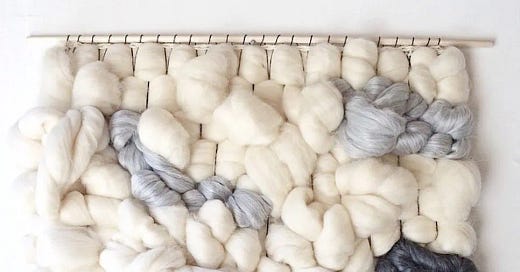


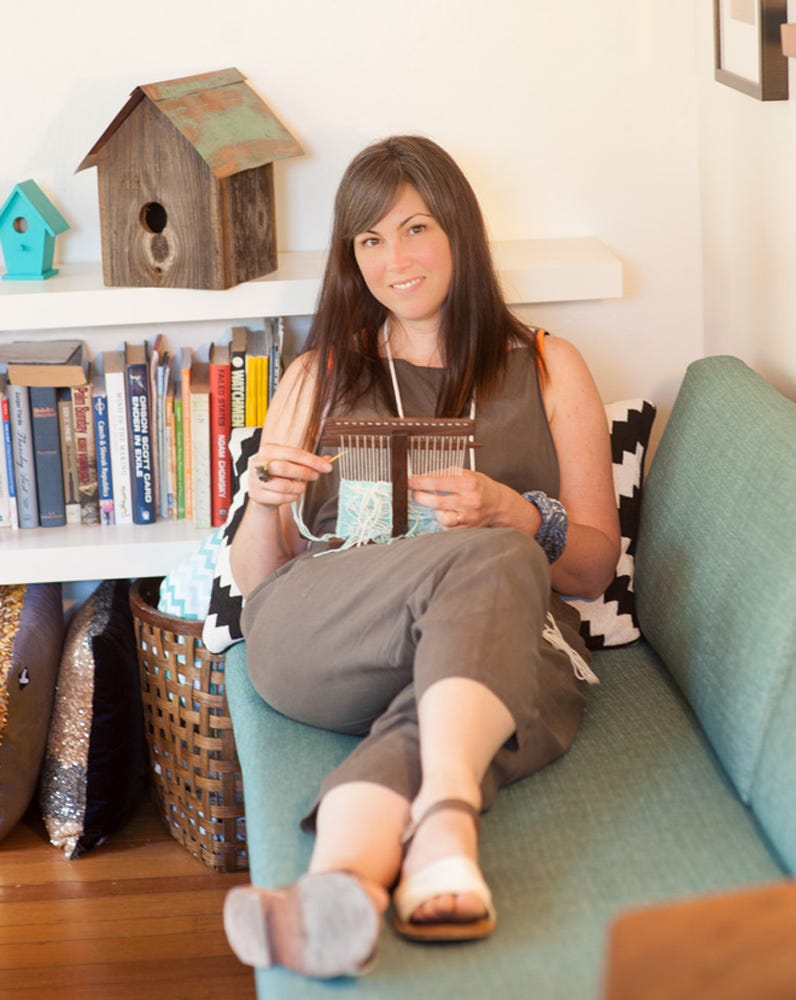
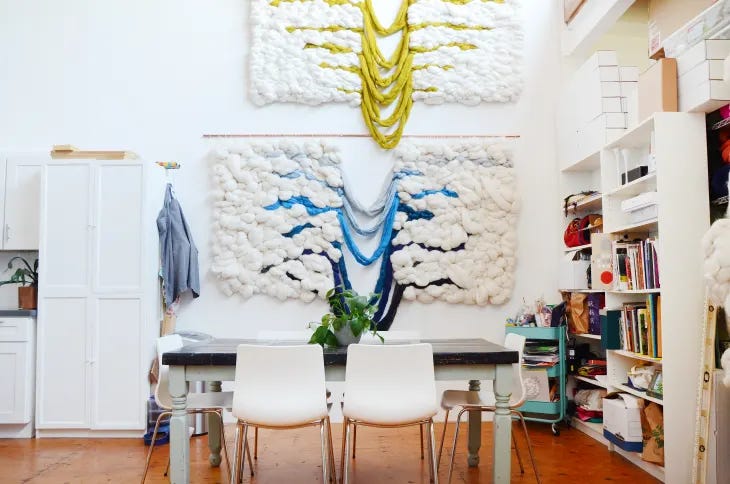
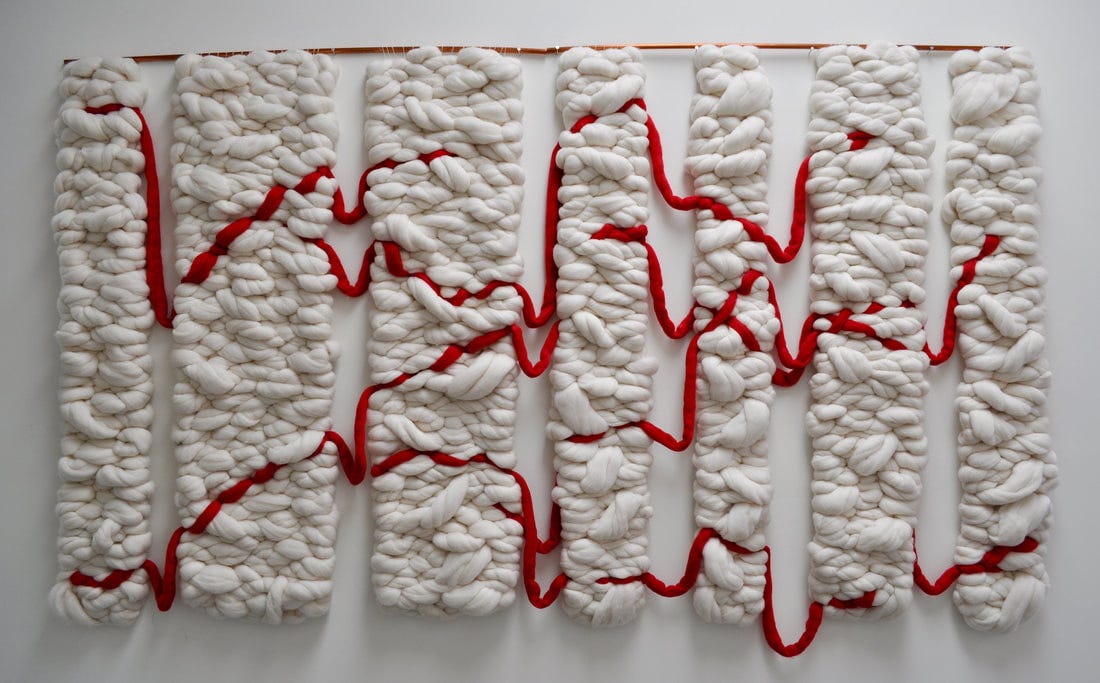

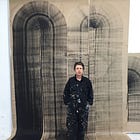

Love this interview and the weaving is so inspiring! As a fellow diviner (I use tarot, playing cards, and many other tools), I find it so interesting how divination and fiber arts are deeply connected. So many cultures have stories about weavers who are also seers!